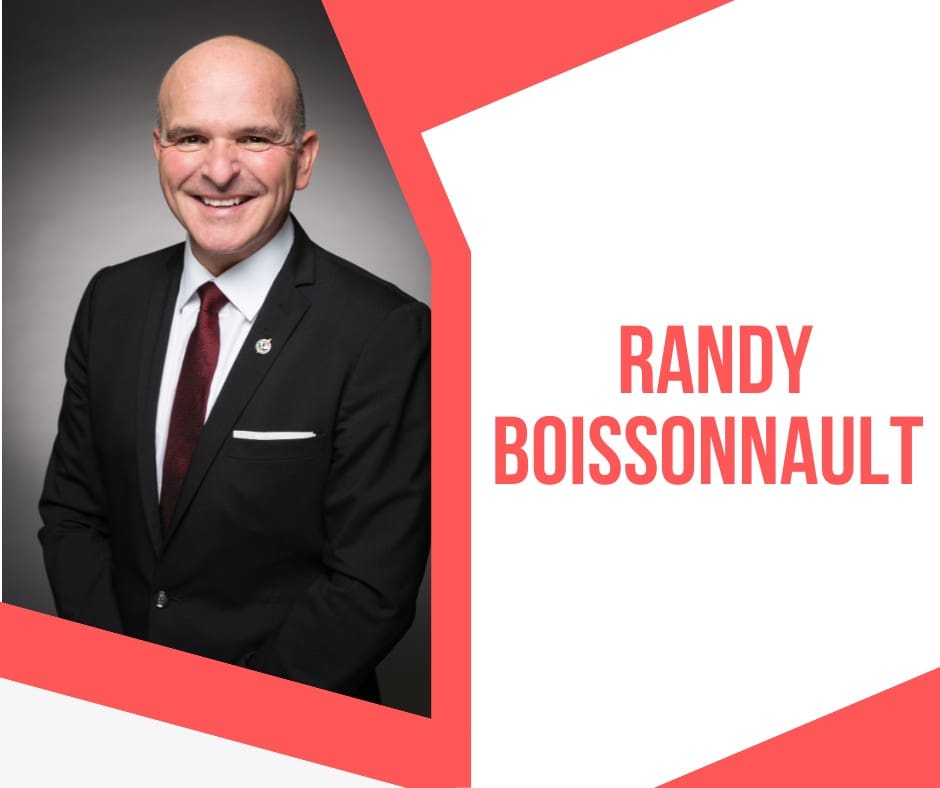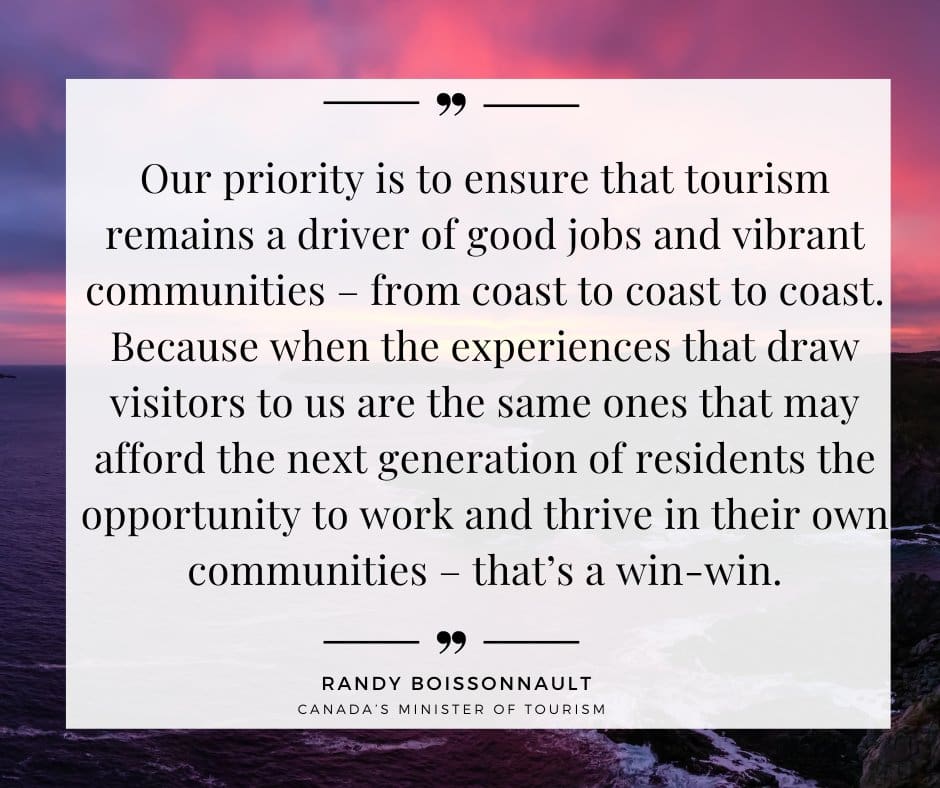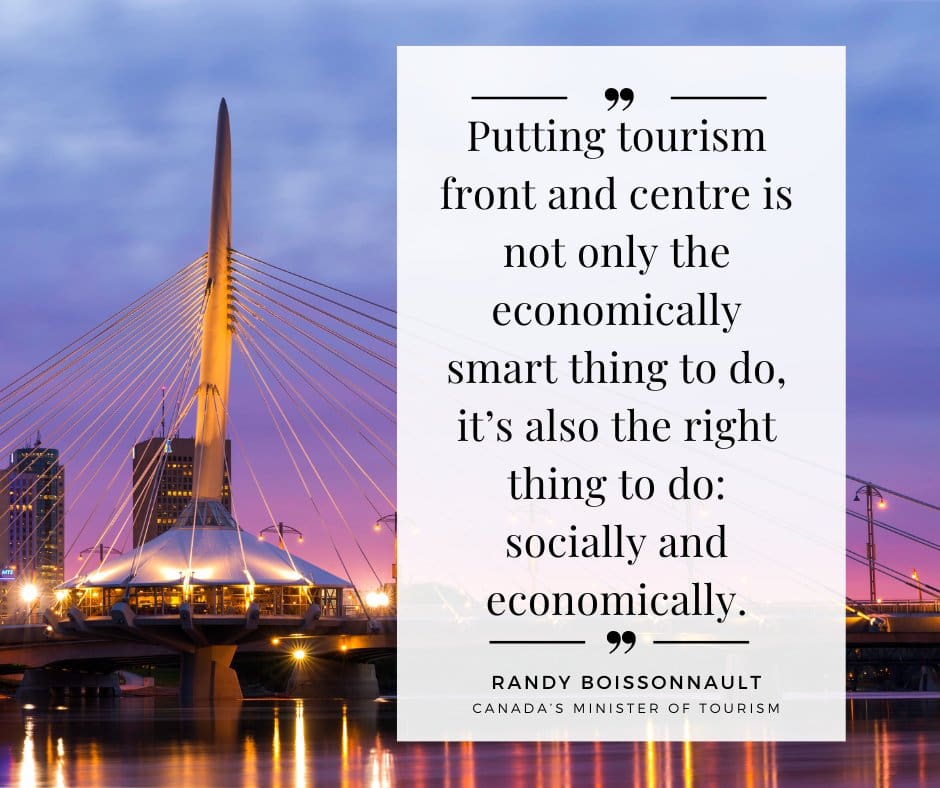
bob mowat
A conversation with Randy Boissonnault, Canada’s Minister of Tourism & Associate Minister of Finance
The Hon. Randy Boissonnault, Minister of Tourism and Associate Minister of Finance, Government of Canada and MP for Edmonton Centre, makes a point in conversation with Travel Courier that: “Tourism is not only a key economic driver, it’s Canada’s largest service export. As such, it is very fitting to say that Canada is powered by Tourism. Yet, we still want to take this concept to the next level, not just for now, but for decades to come.”

I want to start by asking you if it would be accurate to suggest that Canada’s tourism industry has a much higher profile/priority with the federal government these days than it has had in the past? The fact that you are both the Minister of Tourism and the Associate Minister of Finance, certainly suggests that there is a recognition of the industry’s economic importance to Canada. Can you offer some insights?
The fact that the Prime Minister has appointed me as Canada’s first stand-alone tourism minister sends a message to the industry and to our allies that Canada is no longer taking a passive approach to tourism.
I may be the first stand-alone minister, but I am not a work alone minister. There are 23 other ministers who have a responsibility for Tourism, from Immigration to Transport to Labour. Even my colleague, François-Philippe Champagne, at Innovation, Science and Industry, or Marie-Claude Bibeau, at Agriculture, are connected to the mix. I have six regional development agency ministers that are helping to get the money out to our ecosystems.
More importantly, the discussion on tourism has shifted over the last three years. It was one of the most impacted sectors during the pandemic. Our government was there to support the industry with billions of dollars. As we turn the page on that chapter, Our priority is to ensure that tourism remains a driver of good jobs and vibrant communities – from coast to coast to coast. Because when the experiences that draw visitors to us are the same ones that may afford the next generation of residents the opportunity to work and thrive in their own communities – that’s a win-win.

Can you talk about what the federal government’s role is in shaping this country’s tourism strategy? And how important is collaboration with the provinces, territories, and industry in creating that strategy?
Putting tourism front and centre is not only the economically smart thing to do, it’s also the right thing to do: socially and economically.
Many young people, women, racialized Canadians, Indigenous communities, 2SLGBTQI+ people, those with disabilities, and rural residents rely on tourism to make rent and pay the bills.
That’s why, in addition to our government’s historic investments, we have upped the ante on collaboration, including with tourism partners, Indigenous partners, as well as our provincial and territorial counterparts.
During the consultation period for the new Federal Tourism Growth Strategy, I met with tourism partners across Canada, to get a better sense of what the sector needs. I look forward to sharing with you our new Strategy very soon.
Every year, I also meet with my provincial counterparts at the Canadian Council of Tourism Ministers (CCTM), to discuss our priorities for the sector. Working with my provincial counterparts is key to ensuring that we are all on the same page.

As a follow up, I realize that the Federal Tourism Growth Strategy is still a work-in-progress, but I’m wondering if you can offer any hints on what the industry can expect from it once it is released?
While I cannot give you the details of what will be in the FTGS at this time, I can tell you that it is focused on growth and expanding the sector for generations to come. As a government, we are taking a more proactive approach to tourism. We are officially moving from revival mode to building a thriving sector.
The strategy will address challenges in our sector. It will build on competitive advantages such as our great outdoors and authentic Indigenous experiences, just to name a few, so we can ensure that Canada is a destination of choice for the world.

Canada: Powered by Tourism was the theme of Tourism Week 2023 and I’m wondering if you could talk a bit about the economic impact of the industry on the Canadian economy? Do Canadians recognize the economic power of tourism?
Tourism is not only a key economic driver, it’s Canada’s largest service export. As such, it is very fitting to say that Canada is powered by Tourism. Yet, we still want to take this concept to the next level, not just for now, but for decades to come.
Thought-leaders, destination developers, and tourism business owners are already hard at work to future-proof it and make it even more resilient and sustainable.
As a powerful driver of our national economy, here are some numbers:
- Tourism spending in Canada increased by 2.1% in the fourth quarter of 2022, the seventh consecutive quarterly increase.
- Non-resident tourism spending recovered to 88% of pre-pandemic levels.
- Destination Canada has revised their initial forecast for a full recovery by 2024.[1]
If you ask the people working in hotels in Québec city, or in the local café shops in Winnipeg, or the ski instructors at Revelstoke, they surely will tell you that when tourism is in full swing, it makes a big difference in their earnings and it powers their communities.

While the industry’s recovery is underway, it is still suffering from some of the effects (or after-effects) of the pandemic. I know the federal government has supported the tourism industry during the pandemic, but I’m wondering if that support will continue? Can you outline some of the initiatives that are in place to further support the industry?
So, the $158M for tourism in the recent budget is exactly what we said it was. It is to position the sector for growth.
More specifically, Budget 2023 includes $108 million for the Regional Development Agencies over three years starting in 2023-2024 to create even more distinctly Canadian experiences.
This investment is part of the new Federal Tourism Growth Strategy we’re charting for the industry. It will support communities, small businesses, and non-profits to develop creative projects and events for communities from coast to coast to coast.
Budget 2023 also proposes $50 million over the next three years to Destination Canada as they support the country’s tourism industry reach domestic and international visitor markets; specifically, by bringing back Americans (amongst others) and by attracting major national conventions, conferences, and business events.
I can’t get more into the weeds to the Strategy at this time, but I look forward to sharing with you how it will continue to support the growth of the sector and set it up for success for generations to come.

Can you talk a bit about some of the challenges that you see facing the industry going forward? What are they? And what kind of response is needed to overcome them?
If there is one thing that we can do better, it would be to tell the rest of the country, and the world, that tourism is Canada’s #1 service export.
We need to share the fact loudly and proudly. We don’t talk about it enough. Every time somebody comes to our country, it’s booked in our books as an export. We need to lean into that, and we need to own it, and we need to be proud of it.
And guess what?! We need to be even better. The French have 8% of their GDP dedicated to Tourism. We’ve got 2%. The United States is at 3%. Mexico is at 4%…
High costs of living continue to impact business owners, many of them in the tourism sector. Our government is implementing various measures to address the high cost of living, which in turn can help alleviate the burden on business owners. Making life more affordable is one of the government’s primary goals in Budget 2023:
- Through the new Grocery Rebate, Budget 2023 delivers targeted inflation relief for 11 million low- and modest-income Canadians and families who need it most, with up to an extra $467 for eligible couples with two children; an extra $234 for single Canadians without children; and an extra $225 for seniors, on average.
- Lowering credit card transaction fees for small businesses, while also protecting reward points for Canadians offered by Canada’s large banks.
Ultimately, making life more affordable for Canadians and removing obstacles to accessing the workforce makes it easier for us all to work, live, travel and play, for example, by making daycare more affordable. That’s good for everyone.
Building on the foundation the government has been laying since 2015, Budget 2023 delivers a series of major investments to ensure Canada’s clean economy can deliver prosperity, good jobs, and more vibrant communities across Canada.

So, what about the opportunities? You’ve talked a lot about the industry’s potential – at least on the occasions that I’ve seen you speak – can you offer some thoughts on this point?
There are challenges ahead… but even more opportunities on the horizon than there are challenges.
Because in February 2022, when Russia illegally invaded Ukraine, the world fundamentally changed. Allies woke up and realized that they could only really count on each other. And that’s why supply chains are being re-wired, and “friend-shoring” and “near-shoring” is taking place at a rapid pace.
The global reorganisation of trade is changing the way our country is making investments. It has changed the way the United States, Germany, France, South Korea, the European Union are making investments and to build for the future.
It has changed how the world sees Canada – and trade leads travel.
If the cargo – fuels, LNG, hydrogen, critical minerals, and much more – is already being transported and exported, we need the people to follow. And for people to follow, we need to offer them a reason to come visit our country. And Canada has it all!
Wide open spaces and bucket-list adventures, talented workforce as well as an exponential potential for green and sustainable growth. It is up to us to seize this moment.
Together with our tourism ecosystem, we need to develop attractions, events, indigenous experiences to make sure that the trade routes are coming to many cities, in addition to the big ones.
Together, we need to make sure that our tourism experiences connect with what the visitors seek.
To do that, we need to ensure the tourism ecosystem is future-proofed, that labour issues, supply-chains and transportation challenges are addressed. By ensuring the sector has the tools it needs to innovate and find solutions, and by working closely with my other colleagues around the cabinet table, we can ensure Canada continues to be a top-tier destination for visitors from all horizons.

Now, one of the big issues that the industry is dealing with is the labour shortage. And it seems to me that it’s both a problem of not enough people to fill the vacancies, but it’s also a problem of (young) people not viewing the industry as one in which they can have a career. Can you offer some observations on this? And an idea of how the federal government is working with the industry to help alleviate this problem?
Tourism is famously innovative, diverse and inclusive. It employs women, newcomers, youth, racialized Canadians, 2SLGBTQIA+ people, seniors and people with disabilities. It’s 1 in 10 jobs in this country that is connected to tourism. I may be the first stand-alone minister, but I am not a work alone minister. There are 23 other ministers who have a responsibility for Tourism, from Immigration to Transport to Labour. And as such, I work closely with Ministers Sean Fraser at Immigration, as well as Minister O’Reagan at Labour to deal with challenges such as labour shortages. We are well aware that workforce issues continue to be a challenge for the tourism industry, particularly within accommodation and food services. It was raised many times during the FTGS consultations and during meetings with stakeholders.
In Budget 2023, our government proposes multiple measures to support the labour market, where the tourism industry will benefit. This includes extending support for seasonal Employment Insurance claimants, providing up to five additional weeks—for a maximum of 45 weeks—for eligible seasonal workers. In spring 2023, the federal government announced that Canada will launch a new economic pathway under the Economic Mobility Pathways Pilot (EMPP) to help employers hire skilled refugees and other displaced individuals. The EMPP pairs skilled refugees and other qualified displaced individuals with Canadian employers who need to overcome labour shortages in key occupations, including in tourism and hospitality.

In addition, we extended temporary changes to the Temporary Foreign Worker (TFW) Program. These include allowing sectors with demonstrated labour shortages, such as Accommodation and Food Services, to hire up to 30% of their workforce through the TFW Program for low-wage positions for one year (up from 10%). Starting in January 2023, through a temporary two-year measure, Canada also extended work permits to family members of temporary foreign workers. As a result of this new approach, it is estimated that family members of more than 200,000 foreign workers could begin working in Canada, offering a greater opportunity for both foreign workers seeking to work in Canada and for employers addressing their labour need.
Finally, our government has funded Tourism HR Canada for several projects to help the tourism workforce bounce back:
- $3.5 million to establish a Task Force to develop a strategy/framework and tools aimed at addressing systemic and structural issues that will help to address workforce shortages and training needs and set a foundation for growth for the Canadian Tourism Industry (National Priorities Stream-ISED).
- Tourism Workforce Recovery ($4.0 million over three years) will help restore jobs and build resilience with tools to connect job seekers to tourism jobs (Employment and Social Development Canada – ESDC).
- Maintaining a Foundational Labour Market Forecasting and Intelligence System ($3.3 million over three years) will develop enhanced capacity for in-depth labour market research (ESDC).
To all the workers in the tourism sector, I would like to thank you for taking the risk of getting into this business, and for riding the highs and weathering the lows. The rewards of this commitment are multiple and come in many forms. And to the next generations of workers, there is a place for you to have a very fulfilling and long career in this sector… not just a summer job.

TIAC has a number of issues that it has asked the government to take action on – including sustainable funding for Destination Canada; streamlining access for international travellers; and cost competitiveness. How is the federal government responding to TIAC’s concerns?
As the stewards of Canada’s tourism industry, TIAC and its members have been trusted partners in the leap from surviving to reviving to thriving.
We have been working closely with them over the last months, from consultations on the new Federal Tourism Growth Strategy and Budget 2023, to meeting with key stakeholders and collaborating on events.
Beth Potter was very supportive of Budget 2023, where our government recognized the importance of tourism to Canada and supporting its growth. Not only was there $158M invested in the tourism sector, but also measures to grow our net-zero economy, as well as support for border services to improve their screening process, the expansion of the eligibility of low-risk travellers and amendments to the Canada Transportation Act, just to name a few.
I also believe that the new Federal Tourism Growth Strategy will be helpful to chart a course for growth, investment, and stability in Canada’s tourism sector.

Sustainability is a critical issue for the tourism industry not just in Canada, but globally. I’m wondering what kind of policies are in place (or being developed) to help the industry reach the generally accepted goal of Net Zero by 2050?
Over the past two years, the world has continued to change as countries and economies re-orient themselves to new realities around the globe, and the ongoing imperative of climate change. That is influencing the energy demands from countries all over the world.
When Joe Biden came to speak at the House, a couple of months ago, he said the world needs more of what Canada has to offer. Whether it is critical minerals, hydrogen, LNG or oil and gas; Canada has what the world wants.
In fact, we have more critical minerals in Canada than on all of Asia combined. It is important for us to take advantage of that.
We cannot afford to fall behind as the world shifts their economies to net-zero, low-carbon, and sustainable energy solutions. As President Barack Obama said: “Confident countries invest in themselves.” Canada is a confident country. And we are investing in ourselves.
Just look at Budget 2023! We announced transformative investments to build Canada’s 21st century economy, including $80M over 20 years to green our electricity grid.
Our plan includes clear and predictable investment tax credits to provide foundational support for not just clean hydrogen, but also clean technology manufacturing, zero emission technologies, and CCUS. And so, everybody gets to take part in this project to green the electricity grid, even tourism operators and destinations.

Last question… What’s your vision for Canadian tourism?
I want to make sure that our tourism industry soars to new heights. A fully recovered and robust tourism sector is key to our government’s ongoing work to build an economy that works for everyone.
I also want to make sure that Canada’s tourism sector is something we talk about for years to come. No more being shy or being too nice about what we have to offer. From authentic Indigenous experiences to welcoming 2SLGBTQIA+ tourism to breath-taking outdoors and local produce brought to table, we can punch above our weight!


















